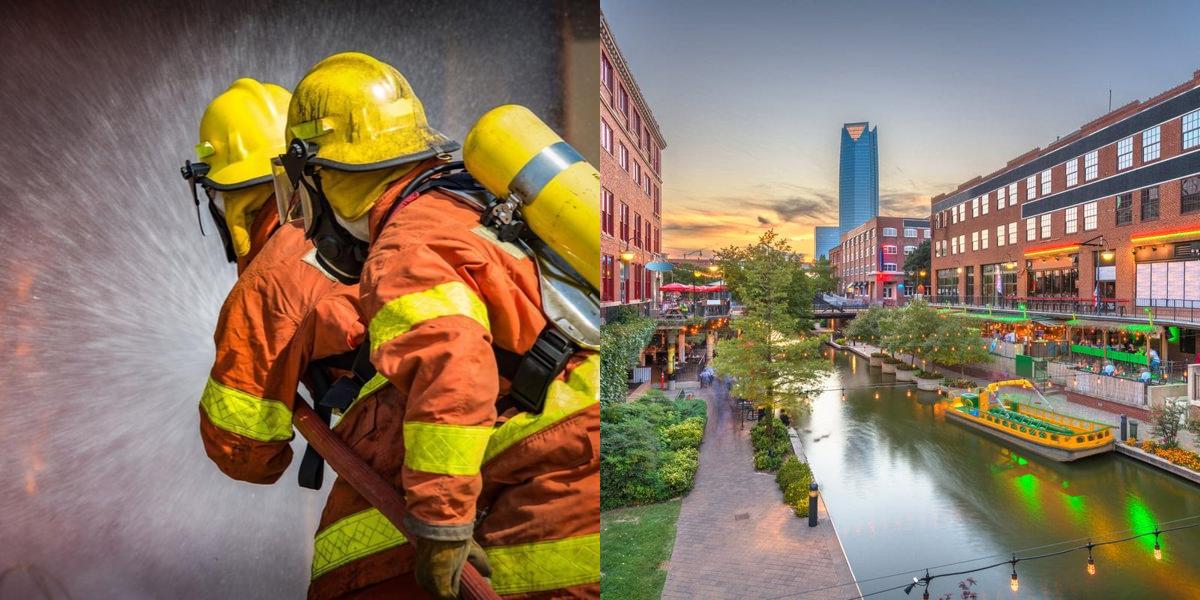How to Become a Firefighter in Oklahoma

Firefighters play a crucial role in society by protecting lives and property from the devastating effects of fires and other emergencies. If you have a strong desire to help others and are interested in pursuing a career as a firefighter in Oklahoma, here is what you need to know.
How do I get a job as a Firefighter?
Once you have obtained your firefighter certification, the next step is to find a job as a firefighter. Here are some steps you can take to increase your chances of securing a firefighting position:
-
Gain volunteer experience: Volunteering with your local fire department is an excellent way to gain hands-on experience and demonstrate your commitment to the firefighting profession. Many fire departments have volunteer programs that allow you to assist with non-emergency tasks, such as equipment maintenance and community outreach. This experience can make your resume stand out and show potential employers that you are dedicated to the field.
-
Network with firefighters: Building connections with current firefighters can be invaluable in your job search. Attend firefighter conferences, workshops, and training events to meet professionals in the field. Networking can provide you with insider information about job openings and increase your chances of getting referred to potential employers.
-
Prepare a strong resume and cover letter: Your resume and cover letter are your first impression to potential employers. Highlight your relevant skills, certifications, and experience in firefighting or related fields. Emphasize your physical fitness, problem-solving abilities, and teamwork skills. Tailor your resume and cover letter to each specific job application to showcase how you meet the requirements of the position.
-
Prepare for interviews: Firefighter interviews are typically rigorous and involve both oral and practical assessments. Prepare for interviews by researching common interview questions and practicing your responses. Be prepared to demonstrate your knowledge of firefighting techniques, your ability to work under pressure, and your commitment to public service. Additionally, practice your physical fitness skills, as some departments may require you to pass a physical agility test during the interview process.
-
Stay physically fit: Firefighting is a physically demanding profession. Regular exercise and maintaining a healthy lifestyle are crucial for both your overall well-being and your ability to perform the job effectively. Stay in shape by engaging in cardiovascular exercises, strength training, and flexibility exercises. Maintaining a healthy weight and ensuring your physical fitness will not only help you pass the physical tests during the hiring process but also make you a more effective firefighter.
-
Stay up to date with industry trends: The firefighting profession is constantly evolving, and it's important to stay up to date with the latest industry trends and advancements. Read industry publications, attend conferences and workshops, and participate in ongoing training opportunities. This demonstrates your commitment to professional growth and can give you a competitive edge in the job market.
-
Apply to multiple fire departments: Firefighting positions can be competitive, so it's important to cast a wide net and apply to multiple fire departments. Research the hiring processes and requirements of different departments and submit your applications accordingly. Be prepared for a potentially lengthy hiring process, as many fire departments have multiple stages of assessment and evaluation.
-
Be patient and persistent: Landing a job as a firefighter may take time and perseverance. The hiring process can be lengthy, and there may be many applicants competing for a limited number of positions. Stay patient and persistent, and use any feedback you receive to improve your skills and qualifications. Keep applying, networking, and honing your skills until you find the right opportunity.
By following these steps and staying dedicated to your goal, you can increase your chances of securing a job as a firefighter and embark on a fulfilling career in public service.
Career Paths and Opportunities after Becoming a Firefighter
Becoming a firefighter opens up a variety of career paths and opportunities. While firefighting itself is a rewarding and fulfilling profession, there are also several potential career advancements and specializations that firefighters can pursue. Here are some of the career paths and opportunities available to firefighters:
-
Fire Officer: Firefighters who demonstrate leadership skills and a strong work ethic may be promoted to the rank of fire officer. Fire officers are responsible for managing and supervising firefighting crews, overseeing emergency responses, and ensuring the safety of both their team and the public. They also play a critical role in developing and implementing fire prevention strategies and protocols.
-
Fire Investigator: Fire investigators are responsible for determining the cause and origin of fires. They use their knowledge of fire behavior, evidence collection, and forensic techniques to investigate the circumstances surrounding a fire. Fire investigators work closely with law enforcement agencies and insurance companies to gather evidence and determine if a fire was accidental or intentional.
-
Fire Inspector: Fire inspectors are responsible for ensuring that buildings and properties comply with fire safety codes and regulations. They conduct inspections to identify potential fire hazards, enforce compliance with fire safety standards, and educate building owners and occupants on fire prevention measures. Fire inspectors play a crucial role in preventing fires and ensuring the safety of the community.
-
Hazardous Materials Specialist: Firefighters with specialized training in hazardous materials response can pursue a career as a hazardous materials specialist. These specialists are trained to handle and respond to incidents involving hazardous materials, such as chemical spills or leaks. They work closely with other emergency response teams to mitigate the risks associated with hazardous materials incidents and protect public health and safety.
-
Fire Training Officer: Fire training officers are responsible for developing and delivering training programs for firefighters. They design and implement training exercises, conduct assessments, and provide ongoing professional development opportunities. Fire training officers play a vital role in ensuring that firefighters are equipped with the necessary skills and knowledge to effectively respond to emergencies.
-
Emergency Management Specialist: Firefighters with a strong background in emergency response and incident management may choose to pursue a career in emergency management. Emergency management specialists are responsible for developing and implementing emergency response plans, coordinating resources during emergencies, and ensuring effective communication and coordination among different response agencies.
-
Fire and Life Safety Educator: Fire and life safety educators work to educate the public about fire safety and prevention. They develop educational materials, conduct presentations, and organize community outreach events to raise awareness about fire hazards and promote fire safety practices. Fire and life safety educators play a critical role in reducing the number of fire incidents and injuries in the community.
-
Specialized Rescue Team Member: Some fire departments have specialized rescue teams that respond to unique and challenging rescue situations, such as water rescues, high-angle rescues, or confined space rescues. Firefighters with specialized training and skills in these areas can join these teams and provide specialized rescue services.
These are just a few examples of the career paths and opportunities available to firefighters. The firefighting profession offers a wide range of opportunities for growth, advancement, and specialization, allowing firefighters to pursue their passions and contribute to the safety and well-being of their communities in various ways.
How Much does a Firefighter Make?
The salary of a firefighter can vary based on factors such as location, experience, and the size of the fire department. According to the Bureau of Labor Statistics, the median annual wage for firefighters was $50,850 in May 2020. The lowest 10 percent earned less than $25,850, while the highest 10 percent earned more than $94,720.
For entry-level firefighters, the starting salary can be lower than the median wage. However, as they gain experience and move up the ranks, their salary can increase significantly. It's important to note that these figures are just averages, and the actual salary can vary depending on various factors.
Final Thoughts
Becoming a firefighter is not just a job; it's a calling. It requires a commitment to public service, physical fitness, and continuous learning. By obtaining your firefighter certification, gaining relevant experience, and staying dedicated to your professional growth, you can increase your chances of securing a job in this rewarding profession.
Dreambound has written dozens of in-depth guides on how to get started in this field, with information specific to your city. If you're located somewhere else or thinking about moving, check out some other guides we've written:
If you're exploring various professional paths, Dreambound has in-depth guides to help assist you. Explore a few of these resources below.

Joanna Paragas is part of the Growth team at Dreambound. Her primary role involves creating various automation to streamline workflows and make tasks more efficient for the entire team. Beyond her professional endeavors, Joanna enjoys spending her free time playing with her dogs and enhancing her knowledge by enrolling in online courses.



